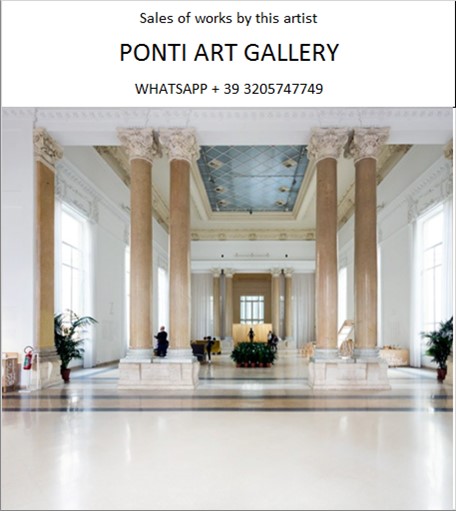Ponti Art Gallery is interested in buying and selling works
of art by this artist.

Giacomo Manzu Biography
Giacomo Manzoni, known professionally as Giacomo Manzù, was an Italian sculptor whose work played a significant role in the art world of the 20th century. Born on December 22, 1908, in the town of Bergamo, Italy, he was the twelfth child of a poor cobbler and sacristan. Despite his humble beginnings and limited formal education, Manzù would rise to become one of Italy's leading artists, renowned for his public sculptures, bas-reliefs, and teaching.
From a young age, Manzù was apprenticed to various craftsmen and carpenters, learning to carve wood and work in metal and stone. His early experiences as an apprentice of woodcarving and his eighteen months of military training in Verona would lay the foundation for his future career as a sculptor. Manzù was largely self-taught in art, but he began his career as a draughtsman and sculptor, drawing inspiration from the Etruscans, Roman and Gothic stonemasons, and the Italian sculptor Medardo Rosso.
In 1928, during his military service in Veneto, Manzù started working with wood, and after a short stay in Paris, he moved to Milan. There, architect Giovanni Muzio commissioned him to decorate the chapel of the Università Cattolica del Sacro Cuore in 1931. This commission marked the beginning of his professional career and his lifelong engagement with religious imagery.
Manzù's early works were characterized by nudes, portraits, and biblical subjects, executed in a style initially influenced by Etruscan, Egyptian, and medieval art. However, he soon adopted the Impressionist techniques of Medardo Rosso, which infused his work with light and materiality. His sculptures often depicted genre subjects and were marked by a sober realism and delicate modeling that alternated between austere severity and sensuousness of form and surface.
In 1933, Manzù exhibited a series of busts at the Triennale di Milano, which granted him national popularity. His work continued to evolve, and in 1938, he began his famous series of Cardinals, enveloping these figures in their liturgical vestments and imbuing them with a profound sense of monumentality and serenity. That same year, he also started a series of bronze bas-reliefs about the death of Jesus Christ, which were criticized by the Fascist government and ecclesiastical authorities when exhibited in Rome in 1942.
During World War II, Manzù moved to Clusone, returning to teach at the Accademia di Brera in Milan after the conflict ended. He held his teaching position until 1954 when he moved to Salzburg, where he lived until 1960. It was during this time that he met Inge Schabel, who would become his future wife and the model for many of his portraits.
Manzù's most significant work is arguably the portal of St. Peter's Cathedral in Rome, the first new doors in the cathedral for 500 years, which he was commissioned to create by Pope John XXIII. This unlikely friendship between the Pope and Manzù, an atheist and a Communist sculptor, resulted in many beautiful works of art, including the bronze "Doors of Death" in St. Peter's, dedicated in 1964.
Throughout his career, Manzù received numerous awards and honors, including the Gold Medal of the Italian Order of Merit for Culture and Art in 1981, the Lenin Peace Prize in 1965, and the Order of Merit of the Italian Republic in 1960. His works are displayed in prestigious museums and private collections around the world.
Manzù's last great work was a 6-meter-tall sculpture facing the United Nations seat in New York City, inaugurated in 1989. He also created sculptures for the Rockefeller Center in New York and was commissioned for works at Wayne State University's McGregor Memorial Sculpture Garden.
Giacomo Manzù died in Rome on January 17, 1991, leaving behind a legacy that continues to influence and inspire. His works remain a testament to his skill, vision, and the profound impact he had on the world of sculpture. A museum dedicated to his art is located in Ardea, near Rome, where he lived and worked from 1964 until his death. Manzù's life and work demonstrate the power of art to transcend boundaries, whether they be of social class, political ideology, or religious belief.
Giacomo Manzu Quotes and Sales
of Works
Ponti Art Gallery selects and deals with paintings by the
artist. Upon request, we provide free estimates and
evaluations, communicate prices, quotations, and current
market values.
If you are interested in BUYING or SELLING works by the
artist, contact us immediately.
If you wish to sell or receive an evaluation of the
works:
Send us a frontal photo of the painting, one of the back,
and one of the signature. Also, indicate the dimensions of
the work. Inform us about the purchase origin of the work
and any kind of available documentation (purchase
receipts, certificates of authenticity, publications). One
of our operators will respond to you on the same day. We
guarantee maximum confidentiality and extreme
professionalism.
If you wish to purchase works by the painter: Contact us
and let us know your request. We will inform you about the
available works. We also offer the possibility to
subscribe to our NEWSLETTER, through which you will be
informed at the beginning of each month about the latest
acquisitions of the art gallery.
You can send us pictures of the work:
